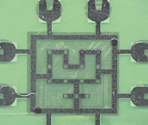Analysing human physiological fluids may require researchers to rethink basics.
Analysing human physiological fluids may require researchers to rethink basics.
Scientists are changing the way that liquids move through microfluidic chips in the race to deliver point-of-care medical devices for clinical diagnosis.
Traditionally, commercial microfluidic chips have liquid continuously flowing through them, which is driven by external pressure sources, such as syringes. This, however, provides little scope for flexibility and requires the chip’s flow channels to be primed with liquid before it can be used. To overcome these difficulties, scientists from Duke University, US, have adopted a droplet-based approach to moving samples of human physiological fluid around a microfluidic chip designed to perform diagnoses.
Vijay Srinivasan and colleagues use a technique known as electrowetting to transport discrete 1.5 µL droplets around a custom-designed chip. They can even split droplets in two, mix them with other reagents and merge them back together. This gives huge scalability advantages and makes reconfiguring a chip much easier.

In the future the team plan to move further towards the development of a bedside diagnostic tool which could be used for routine patient care. ’Analytical performance parameters such as specificity, sensitivity, precision, recovery and interferences also need to be measured to evaluate clinical applicability’, Srinivasan commented.
Ian Farrell
References
V Srinivasan, V K Pamula and R B Fair, Lab Chip, 2004 (DOI: 10.1039/ <MAN>b403341h</MAN>)






No comments yet